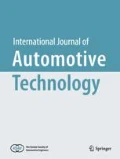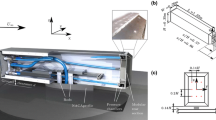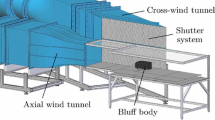Abstract
A ground-effect diffuser is an upwardly-inclined section of an automobile’s underbody which increases aerodynamic performance by generating downforce. To understand the diffuser flow physics (force behaviour, surface and offsurface flow features), we established the near-wake (within one vehicle width of the base) velocity profiles and flow structures of an automotive ground-effect diffuser using a bluff body with a 17 degree slanted section forming the plane diffuser ramp surface (baseline geometry), and endplates extending along both sides of the ramp. Wind tunnel experiments were conducted at a Reynolds number of 1.8 million based on the bluff body length, and laser Doppler velocimetry was used to measure two-dimensional velocity components on three planes of the diffuser near-wake. We also measured the velocity field in the near-wake of diffusers with modified geometry (with an inverted wing or a convex bump) as passive flow control devices. The near-wake velocity profiles indicated that the passive flow control methods increased the diffuser flow velocity and that the longitudinal vortices along the diffuser determined the shape of the flow structures in the near-wake of the diffuser bluff body.
Similar content being viewed by others
Abbreviations
- A S :
-
bluff body frontal area, m2
- C D :
-
drag coefficient, D/(q∞AS)
- C L :
-
lift coefficient, L/(q∞AS)
- d :
-
diffuser half width, m
- D :
-
aerodynamic drag, N
- D p :
-
seeding particle diameter, m
- f :
-
focal length of the LDV probe lens, m
- h :
-
bluff body model ride height, m
- l :
-
bluff body length, m
- L :
-
aerodynamic lift (positive upwards), N
- LDV:
-
laser doppler velocimetry
- q ∞ :
-
freestream dynamic pressure (ρU∞2/2), Pa
- Re :
-
Reynolds number based on l and U∞
- T c :
-
flow characteristic timescale, s
- U ∞ :
-
freestream velocity, ms−1
- U w :
-
downstream flow velocity, ms−1
- U :
-
total velocity in x-y plane √u2+v2, ms−1
- u′:
-
root mean square of turbulent velocity fluctuations, ms−1
- ΔU :
-
plane diffuser U - modified diffuser U, ms−1
- Δu′:
-
plane diffuser u′ - modified diffuser u′, ms−1
- u :
-
velocity component in x direction, ms−1
- v :
-
velocity component in y direction, ms−1
- x :
-
cartesian coordinate: x is positive downstream of origin at the start of underbody flat section (Figure 4 (a))
- y :
-
cartesian coordinate: y is positive upwards of origin on the ground plane (Figure 4 (a))
- z :
-
cartesian coordinate: z is positive portside of origin on the centreline of the body (Figure 4 (a))
- Γ:
-
circulation, m2s−1
- μ :
-
dynamic viscosity kgm−1s−1
- ρ :
-
air density, kgm−3
- ρ p :
-
seeding particle density, kgm−3
References
Barlow, J. B., Rae, W. H. and Pope, A. (1999). Low-speed Wind Tunnel Testing. 3rd edn. Wiley. New York, USA, 176.
Benedict, L. and Gould, R. (1996). Towards better uncertainty estimates for turbulence statistics. Experiments in Fluids 22, 2, 129–136.
Benedict, L. and Gould, R. (1996). Towards better uncertainty estimates for turbulence statistics. Experiments in Fluids 22, 2, 129–136.
Cooper, K. R., Bertenyi, T., Dutil, G., Syms, J. and Sovran, G. (1998). The aerodynamic performance of automotive underbody diffusers. SAE Paper No. 980030.
Cooper, K. R., Sovran, G. and Syms, J. (2000). Selecting automotive diffusers to maximise underbody downforce. SAE Paper No. 2000-01-0354.
Dring, R. P. (1982). Sizing criteria for laser anemometry particles. J. Fluids Engineering 104, 1, 15–17.
Ehirim, O. H. (2017). Aerodynamics and Performance Enhancement of a Ground-effect Diffuser. Ph. D. Dissertation. Cranfield University. Bedford, UK.
George, A. R. (1981). Aerodynamic effects of shape, camber, pitch on ground-vehicle bodies. J. Fluids Engineering 103, 4, 631–637.
George, A. R. and Donis, J. (1983). Flow patterns, pressures and forces on the underside of idealised ground effect vehicles. Proc. ASME Fluids Engineering Division Symp. Aerodynamics of Transportation II, 7, 69–79.
Hucho, W.-H. (1998). Aerodynamics of Road Vehicles. 4th edn. Society of Automotive Engineers. Washington, USA, 392–395.
Jowsey, L. and Passmore, M. (2010). Experimental study of multiple-channel automotive underbody diffusers. Proc. Institution of Mechanical Engineers, Part D: J. Automobile Engineering 224, 7, 865–879.
Jowsey, L. (2013). An Experimental Study of Automotive Underbody Diffusers. Ph. D. Dissertation. Loughborough University. Loughborough, UK.
Katz, J. (2006). New Directions in Race Car Aerodynamics. 2nd edn. Bentley Publishers. Cambridge, Massachusetts, USA, 221–222.
Knowles, K. and Finnis, M. V. (1998). Development of a new open-jet wind tunnel and rolling road facility. 2nd MIRA Int. Conf. Vehicle Aerodynamics, Coventry, UK.
Knowles, R. (2005). Monoposto Racecar Wheel Aerodynamics: Investigation of Near-wake Structure and Support-sting Interference. Ph. D. Dissertation. Cranfield University. Bedford, UK.
Krajnovic, S. and Davidson, L. (2001). Large-eddy simulation of the flow around a ground vehicle body. SAE Paper No. 2001-01-0702.
McKeon, B. et al. (2007). Velocity, Vorticity and Mach Number. Springer Handbook of Experimental Fluid Mechanics. Springer-Verlag Berlin Heidelberg. Heidelberg, Germany, 296–309.
Nobach, H. (2000). A global concept of autocorrelation and power spectral density estimation from LDA data sets. 10th Int. Symp. Applications of Laser Techniques to Fluid Mechanics, Instituto Superior Técnico, Lisbon, Portugal.
Puglisevich, L. S. (2013). Large Eddy Simulation for Automotive Vortical Flows in Ground Effect. Ph. D. Dissertation. Loughborough University. Loughborough, UK.
Puglisevich, L. S. and Page, G. (2011). Large eddy simulation of the flow around a diffuser-equipped bluff body in ground effect. ASME Proc. Fluids and Thermal Systems, 313–322.
Senior, A. (2002). The Aerodynamics of a Diffuser-Equipped Bluff Body in Ground Effect. Ph. D. Dissertation. University of Southampton. Southampton, UK.
Senior, A. E. and Zhang, X. (2001). The force and pressure of a diffuser-equipped bluff body in ground effect. J. Fluids Engineering 123, 1, 105–111.
Sovran, G. (1994). The kinematic and fluid-mechanic boundary conditions in underbody flow simulation. Proc. CNR-Pininfarina Workshop on Wind Tunnel Simulation of Ground Effect, Turin, Italy.
Toet, W. (2013). Aerodynamics and aerodynamic research in formula 1. Aeronautical Journal 117, 1187, 1–26.
Zerihan, J. and Zhang, X. (2000). Aerodynamics of a single-element wing in ground effect. J. Aircraft 37, 6, 1058–1064.
Zhang, X., Senior, A. and Ruhrmann, A. (2004). Vortices behind a bluff body with an upswept aft section in ground effect. Int. J. Heat and Fluid Flow 25, 1, 1–9.
Zhang, X., Toet, W. and Zerihan, J. (2006). Ground effect aerodynamics of race cars. J. Fluids Engineering 59, 1, 33–49.
Author information
Authors and Affiliations
Corresponding author
Rights and permissions
About this article
Cite this article
Ehirim, O., Knowles, K., Saddington, A. et al. On the Near-Wake of a Ground-Effect Diffuser with Passive Flow Control. Int.J Automot. Technol. 20, 11–23 (2019). https://doi.org/10.1007/s12239-019-0002-2
Received:
Revised:
Accepted:
Published:
Issue Date:
DOI: https://doi.org/10.1007/s12239-019-0002-2




